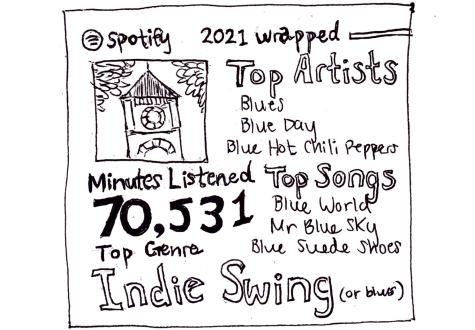Why wrap presents when you can wrap Spotify?
December 9, 2021
On Dec. 1, Instagram users flooded their stories with variations on the same template: a purple or black or blue or green background, a looping “2021” in a funky font, a list of musical artists and songs, a number of minutes ranging anywhere from several thousand to several hundred thousand; and an album cover, which reflected that user’s most-listened-to artist of the year.
It was “Spotify wrapped day,” when the audio-streaming service Spotify presents users with definitive data about what they listened to the most this year, breaking it down by artist, genre, time spent listening and, this year, “aura” (a combination of a user’s two most listened-to “moods” ranging from “hype” to “energy” to “wistful” to “yearning.”) Users can boast that they were in their favorite artist’s top 0.1 percent of listeners this year or finally confront that they really listened to “drivers license” 23,456 times. For many, it’s a source of pride, a chance to show off what they spent a lot of their year doing, and usually independently—Spotify has a “friends” feature so you can see what people you know are listening to, but unless you’re paying attention to it 24/7, you don’t get a real sense of their tastes. The “Wrapped” posts also let you see the music tastes of people you may only kind of know: whoever you follow on Instagram.
For others, it’s a source of lighthearted shame, an aggregate of private moments shared with faux-embarrassed glee (literally, in the case of Glee covers that clinch top-five spots). Spotify Wrapped reveals the indie-aspirant’s mainstream taste, the jilted lover’s hours spent listening to FKA twigs’ “cellophane,” the Olivia Rodrigo hater’s secret affinity for “drivers license.” In the weeks leading up to the much-anticipated Wrapped release day (jokingly dubbed “Twitter’s met gala” and “gay Christmas” online), people share anxiety at the imminent exposure of their year’s listening habits. Days before Spotify stops counting data at the end of October, Twitter users remind one another to “fix” their Wrapped statistics while they still can. Well-known hits need to be supplanted by obscure tracks; highbrow classics must replace juvenile bubblegum-pop. Some Spotify users even create playlists with titles like “Fixing My Spotify Wrapped,” carefully calibrated lists of tracks they hope to see in their Top 100.
When asked to identify the most “embarrassing” part of her 2021 Spotify Wrapped, Resident Director Blythe Eickerman said that it was Taylor Swift taking her top artist spot.
“I don’t know how she snuck up there,” Eickerman said via email. “I think it’s because I have a song or two of hers on a lot of my playlists and that adds up.”
I find myself similarly justifying my less triumphant stats. My vaguely embarrassing number-one track of the year was, indeed, “drivers license”—yes, I did listen to it almost exclusively for days after it came out, but I haven’t listened to it that much since, I insisted, upon seeing it. Last year, my sad-girl Wrapped seemed so psychologically worrisome that I had to post it with the disclaimer that I was in therapy. (Simply not posting it, of course, wasn’t an option.)

It is pretty interesting the way Spotify Wrapped turns listening to music, often a private and emotionally intimate experience, into something contrived and public—all part of a larger performance. Earlier this year, when I spent a few weeks obsessed with Glee’s seminal “I Feel Pretty/Unpretty” mashup, I briefly considered purchasing it on iTunes, just to prevent it from showing up later in my Wrapped. A dollar twenty-nine was nearly forfeited, just for the sake of my Spotify Wrapped pride!
“I make sure not to listen to embarrassing music anymore, like musicals and the Glee cast, because I have been burned before by that,” junior Katie Chilton said. “Every now and then I’ll intentionally listen to a cooler artist to get them in my Wrapped.”
Chilton didn’t even post her Wrapped to social media, but still found herself consciously shifting her listening habits with it in mind. She described her list of top artists as relatively mainstream (including One Direction, whom she “can’t escape”), and felt that this might be slightly looked down upon by other Whitman students.
Both Eickerman and Chilton also saw apt reflections of their emotional states this year in some of their top songs. Eickerman, for whom music can be a method of coping, can distinctly remember the portion of the year during which “Green” by Cavetown played on loop.
“It’s a neat way to see how I lived my life this past year in a way that resonates with me,” she said.
For Chilton, songs like “Liability” by Lorde reflect the difficulties of 2021; she attributes its presence in her Top 5 to having had “a tougher year than usual.” Wrapped acts as a time capsule of sorts, capturing the year’s most prominent emotions through music.
“Just glad the Glee cast didn’t make it in this year,” Chilton said.
(What did the Glee cast ever do to us?)





